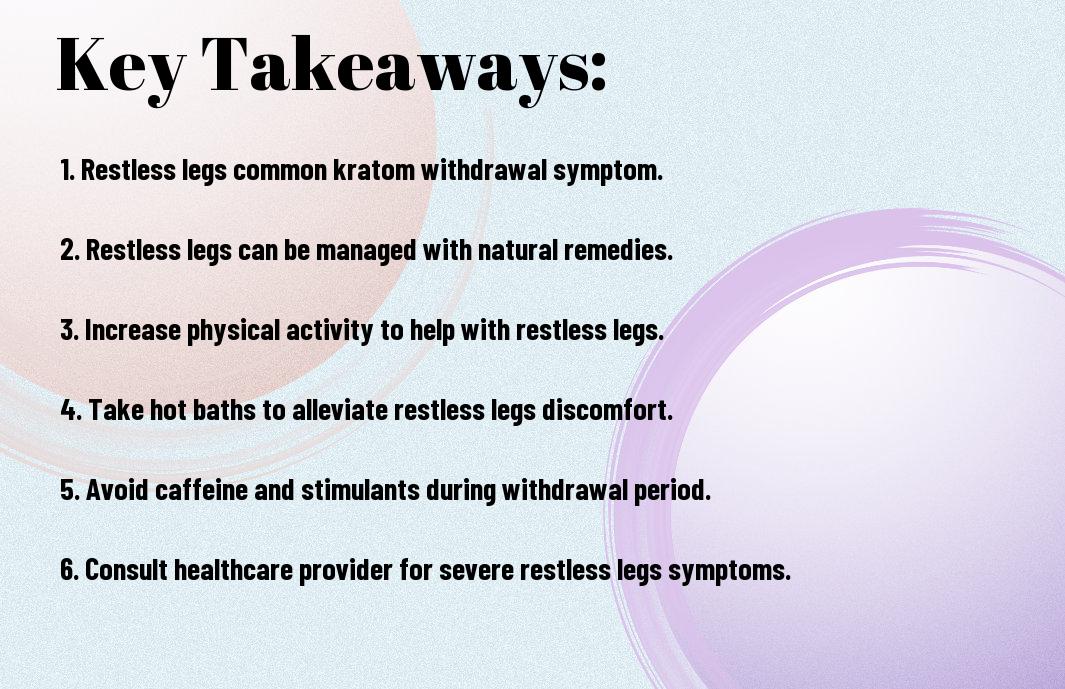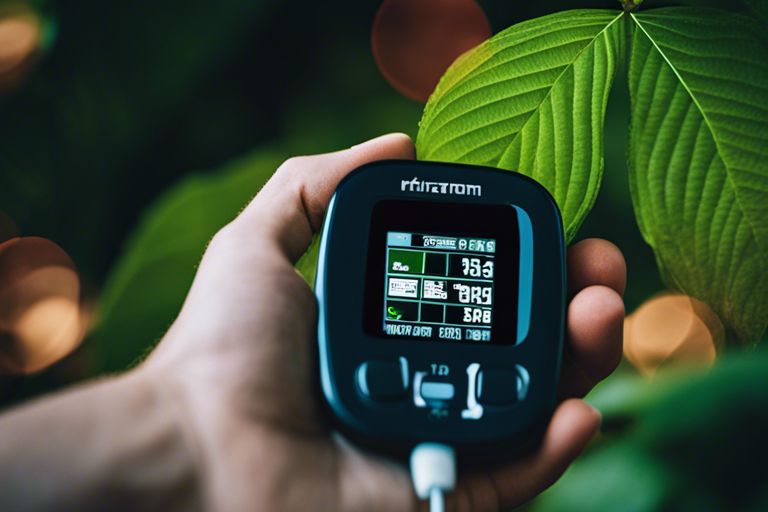There’s an often overlooked symptom that accompanies kratom withdrawal – restless legs. This uncomfortable sensation, coupled with other withdrawal symptoms, can make the process challenging. Understanding the causes and remedies for restless legs during kratom withdrawal is crucial for anyone considering discontinuing kratom use. Let’s research into how to manage this distressing symptom and navigate through kratom withdrawal with greater ease.
Key Takeaways:
- Kratom withdrawal can lead to restless legs syndrome (RLS), a condition characterized by uncomfortable sensations in the legs and an irresistible urge to move them.
- Common symptoms of RLS during kratom withdrawal include twitching, tingling, crawling sensations, and an overall discomfort in the legs, usually exacerbated at night.
- Managing kratom withdrawal restless legs may involve strategies such as staying hydrated, maintaining a balanced diet, engaging in regular exercise, and practicing relaxation techniques to help alleviate symptoms.

What is Kratom?
For centuries, kratom has been used as a traditional medicine in Southeast Asia. The plant, scientifically known as Mitragyna speciosa, is native to countries like Thailand, Indonesia, Malaysia, and Papua New Guinea. Kratom leaves are typically chewed, brewed into tea, or ground into a powder for various medicinal purposes.
Definition and History
History: Kratom has a long history in traditional medicine, where it has been used to alleviate pain, boost energy, and relieve opioid withdrawal symptoms. However, in recent years, kratom has gained popularity in the West as an alternative treatment for chronic pain, anxiety, and depression.
Legal Status and Availability
For many individuals seeking relief from pain or mood disorders, kratom’s legal status and availability can be a determining factor in its use. Currently, kratom is legal in the United States at the federal level, but some states and cities have implemented their restrictions or bans on the substance. It is vital to research and understand the laws and regulations surrounding kratom in your area before using it.
What makes kratom particularly appealing to some people is its easy accessibility. Kratom can be purchased online, in specialty stores, or even at certain gas stations and convenience stores. This availability has contributed to its growing popularity as a natural alternative for pain management and mood enhancement.
How Does Kratom Affect the Body?
Mechanism of Action
The mechanism of action of kratom is similar to that of opioids. The active compounds in kratom, such as mitragynine and 7-hydroxymitragynine, bind to the mu-opioid receptors in the brain, producing pain relief and a sense of euphoria. Additionally, kratom also affects other neurotransmitter systems, including serotonin and dopamine, which contribute to its stimulating effects.
Short-Term Effects
On a short-term basis, kratom can produce effects such as increased energy, improved focus, and analgesia. Users may also experience feelings of relaxation and well-being. However, these effects can vary depending on the strain and dosage of kratom consumed.
Does
Long-Term Effects
One of the potential long-term effects of kratom use is the development of dependence and tolerance. This means that over time, individuals may require higher doses of kratom to achieve the same effects, leading to a cycle of escalating use. Chronic kratom use has also been associated with adverse effects on liver function and mental health.
This includes an increased risk of depression and anxiety.

Kratom Withdrawal Symptoms
Common Symptoms
Symptoms of kratom withdrawal can vary in intensity and duration depending on factors such as the amount and frequency of kratom use. Common withdrawal symptoms include anxiety, irritability, nausea, muscle aches, insomnia, and sweating. These symptoms can be uncomfortable but are usually not life-threatening.
Timeline of Withdrawal
With kratom withdrawal, symptoms typically begin within 12-24 hours after the last dose. The acute withdrawal phase usually peaks within 2-3 days and can last up to a week. However, some individuals may experience a longer duration of withdrawal symptoms.
Withdrawal symptoms may include a combination of physical and psychological effects, making it challenging for individuals to cope without professional support and guidance.
Severity of Withdrawal
Kratom withdrawal symptoms can range in severity from mild to severe. Factors such as the duration of kratom use, dosage, and individual differences can influence the severity of withdrawal symptoms. Severe symptoms may include intense cravings, depression, and pronounced mood swings. In some cases, individuals may also experience hallucinations or delusions, which can be dangerous and require immediate medical attention.
Restless Legs Syndrome (RLS)
Definition and Causes
Any discussion about restless legs syndrome (RLS) must begin with understanding its definition and causes. RLS is a neurological disorder characterized by an irresistible urge to move the legs to relieve uncomfortable sensations. The exact cause of RLS is not fully understood, but researchers believe it could be due to abnormalities in dopamine levels in the brain, genetic factors, or certain medical conditions.
Symptoms and Diagnosis
The diagnosis of RLS is primarily based on a patient’s description of symptoms. The four key characteristics include an urge to move the legs, unpleasant sensations in the legs, symptoms that worsen at rest or in the evening, and relief with movement. Symptoms can vary in severity and may disrupt sleep, leading to daytime drowsiness and impaired functioning.
The diagnosis of RLS is usually made clinically, based on a patient’s history and symptoms. In some cases, doctors may order blood tests or sleep studies to rule out other conditions that could be causing similar symptoms.
Treatment Options
Restless legs syndrome can be challenging to treat, but several options are available to help manage symptoms. Lifestyle changes such as incorporating regular exercise, establishing a sleep routine, and avoiding caffeine and alcohol can be beneficial. For instance, medications that increase dopamine levels in the brain, such as ropinirole or pramipexole, may also be prescribed to alleviate symptoms.
The Connection Between Kratom Withdrawal and RLS
Why Kratom Withdrawal Can Trigger RLS
All too often, individuals who have been using kratom regularly may experience restless legs syndrome (RLS) during kratom withdrawal. RLS is a neurological disorder that causes uncomfortable sensations in the legs and an irresistible urge to move them. The cessation of kratom can disrupt the body’s natural balance, leading to neurochemical changes in the brain that may contribute to the development of RLS symptoms during withdrawal.
How RLS Affects Kratom Withdrawal Symptoms
The onset of RLS can exacerbate the symptoms of kratom withdrawal. During this already challenging period, the discomfort and restlessness in the legs caused by RLS can further agitate individuals undergoing kratom withdrawal, making the experience even more distressing.
The relationship between RLS and kratom withdrawal is a complex interplay of biological and neurological factors, which underscores the need for tailored approaches to managing both conditions simultaneously.
Managing RLS During Kratom Withdrawal
With the dual challenge of combating kratom withdrawal symptoms and managing RLS, it is crucial to adopt a multifaceted approach. Managing RLS symptoms during kratom withdrawal can involve lifestyle modifications, such as incorporating regular exercise, maintaining a balanced diet, and practicing relaxation techniques. Additionally, consulting with a healthcare provider for potential medications or supplements to alleviate RLS symptoms may be beneficial.
Withdrawal from kratom can be a challenging journey, particularly when compounded by the presence of RLS. However, with proper support and a comprehensive strategy that addresses both kratom withdrawal and RLS symptoms, individuals can navigate this period with greater ease and comfort.
Coping with Kratom Withdrawal Restless Legs
Lifestyle Changes
Keep restless legs at bay during kratom withdrawal by incorporating some lifestyle changes. Regular exercise, especially in the form of moderate aerobic activity like walking or biking, can help alleviate symptoms of restless legs. Additionally, practicing relaxation techniques such as yoga or meditation before bedtime may improve sleep quality and reduce the intensity of restlessness.
Natural Remedies
On the natural front, consider using magnesium supplements to help relax muscles and reduce the discomfort associated with restless legs. Another beneficial natural remedy is iron supplementation, as low iron levels can exacerbate symptoms of restless legs. Furthermore, taking a warm bath before bedtime or using heating pads on the legs can provide immediate relief and promote relaxation.
One crucial oil that has shown promise in alleviating restless legs is lavender oil. It can be applied topically or diffused in the room to help calm the nerves and reduce restlessness.
Medications and Supplements
Coping with severe restless legs during kratom withdrawal may require the use of medications or supplements. Prescription medications like gabapentin or clonidine are commonly prescribed to manage restless legs symptoms. Over-the-counter remedies such as iron or vitamin supplements may also be beneficial in addressing underlying deficiencies that contribute to restless legs.
On a cautionary note, it’s crucial to consult a healthcare provider before starting any medications or supplements to ensure they are safe and appropriate for your individual needs.
Professional Help and Support
To cope with kratom withdrawal-related restless legs, seeking professional help and support from a healthcare provider or therapist can be invaluable. Cognitive-behavioral therapy (CBT) has shown effectiveness in managing restless legs and improving sleep patterns. Support groups or online forums can also provide a sense of community and understanding during this challenging time.
Summing up
Drawing together the information on kratom withdrawal restless legs syndrome highlighted in this article, it is evident that this symptom is a common part of the withdrawal process when discontinuing kratom use. While uncomfortable, it is typically temporary and can be managed with various strategies such as stretching, hot baths, and ensuring proper hydration and nutrition. It is vital to seek support from healthcare providers or addiction specialists during this time to ensure a safe and effective withdrawal process.
For further information on kratom withdrawal and its duration, you may refer to an article on How Long Does Kratom Withdrawal Last?
Can Using Magnesium Citrate Help with Kratom Withdrawal Restless Legs?
For those experiencing Kratom withdrawal restless legs, a kratom and magnesium citrate blend may offer relief. Magnesium citrate is known for its muscle-relaxing properties, which can help alleviate the discomfort of restless legs during withdrawal. Incorporating this blend into your regimen may provide much-needed comfort during this challenging time.
FAQ
Q: What are restless legs during kratom withdrawal?
A: Restless legs during kratom withdrawal are characterized by uncomfortable sensations in the legs, leading to an uncontrollable urge to move them. This sensation often worsens at night, making it difficult to sleep.
Q: What causes restless legs during kratom withdrawal?
A: Restless legs during kratom withdrawal are believed to be caused by the body adjusting to the absence of kratom, a substance that affects the central nervous system. Changes in dopamine levels and nervous system activity may contribute to these uncomfortable sensations.
Q: How long do restless legs last during kratom withdrawal?
A: Restless legs during kratom withdrawal can last anywhere from a few days to a few weeks, depending on individual factors such as dosage, duration of kratom use, and overall health. In some cases, symptoms may persist for months.
Q: How can I alleviate restless legs during kratom withdrawal?
A: There are several strategies to alleviate restless legs during kratom withdrawal, including gentle exercise, warm baths, massage, and stretching. Avoiding caffeine, nicotine, and alcohol can also help reduce symptoms. In severe cases, medication may be prescribed by a healthcare provider.
Q: When should I seek medical help for restless legs during kratom withdrawal?
A: If restless legs during kratom withdrawal are severe and affecting your quality of life, it is important to seek medical help. A healthcare provider can provide guidance on managing symptoms and may recommend treatment options to help you through the withdrawal process.










